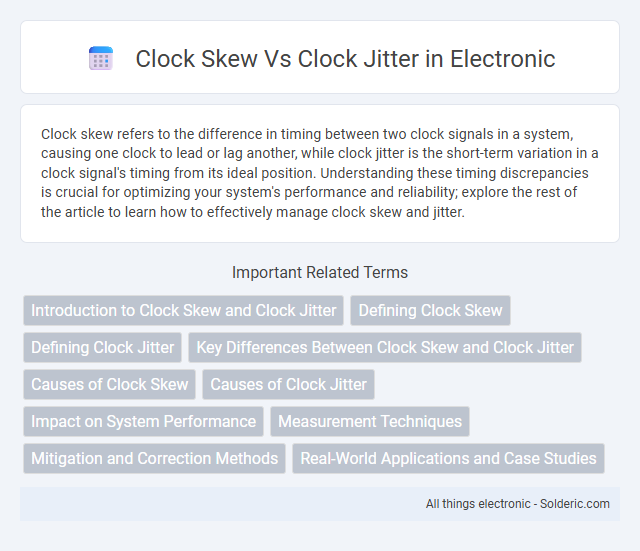Clock skew refers to the difference in timing between two clock signals in a system, causing one clock to lead or lag another, while clock jitter is the short-term variation in a clock signal's timing from its ideal position. Understanding these timing discrepancies is crucial for optimizing your system's performance and reliability; explore the rest of the article to learn how to effectively manage clock skew and jitter.
Comparison Table
| Aspect | Clock Skew | Clock Jitter |
|---|---|---|
| Definition | Constant or slowly varying time difference between two clock signals | Rapid, short-term variations in clock signal timing |
| Nature | Deterministic and often static | Random and dynamic |
| Impact | Causes timing misalignment between circuits or devices | Leads to timing uncertainty and data errors |
| Measurement | Measured in time difference (nanoseconds) | Measured in peak-to-peak or RMS time deviations |
| Cause | Differences in clock distribution paths or delays | Noise, signal integrity issues, power supply variations |
| Effect on Systems | May affect synchronization and setup/hold times | Impacts signal integrity and increases bit error rate |
Introduction to Clock Skew and Clock Jitter
Clock skew refers to the difference in timing between clocks in a synchronous system, often caused by variations in signal path delays, leading to synchronization errors. Clock jitter is the deviation from true periodicity of a clock signal, characterized by short-term variations in timing that degrade signal integrity and performance. Both clock skew and jitter critically impact timing accuracy in digital circuits and communication systems, necessitating precise measurement and mitigation techniques.
Defining Clock Skew
Clock skew refers to the difference in timing between clock signals arriving at different components within a digital system, causing synchronization challenges. It occurs due to variations in clock path delays, leading to timing mismatches that can degrade circuit performance and reliability. Your system's design must account for clock skew to ensure accurate timing and data integrity across all synchronous elements.
Defining Clock Jitter
Clock jitter refers to the small, rapid variations in the timing of a clock signal's edges, causing deviations from the ideal periodicity. It impacts the precision of timing circuits by introducing uncertainty in signal transitions, which differs from clock skew that involves a systematic timing difference between clock signals across components. Understanding clock jitter is essential for maintaining signal integrity and ensuring the reliability of high-speed digital systems.
Key Differences Between Clock Skew and Clock Jitter
Clock skew refers to the time difference between clocks at different components in a system, causing synchronization issues, whereas clock jitter signifies the small, rapid variations in a clock signal's timing from its ideal position. Skew impacts how data is aligned across multiple devices, often leading to setup and hold time violations, while jitter affects signal integrity and can cause bit errors by disturbing the timing of individual clock cycles. Understanding these distinctions helps you design more reliable timing systems and improve overall circuit performance.
Causes of Clock Skew
Clock skew primarily arises from variations in signal propagation delays caused by differences in wire lengths, temperature fluctuations, and manufacturing imperfections across integrated circuits. These delays impact synchronization by causing clock signals to arrive at different components at slightly different times. Understanding these physical and environmental factors helps you design more robust timing strategies in digital systems.
Causes of Clock Jitter
Clock jitter is primarily caused by noise in the power supply, temperature variations, and electromagnetic interference, which introduce variability in signal timing. Process variations in semiconductor manufacturing and imperfect clock distribution networks also contribute significant clock jitter. These factors lead to unpredictable deviations in clock signal edges, impacting system synchronization and timing accuracy.
Impact on System Performance
Clock skew causes timing discrepancies between clock signals in different parts of a system, leading to synchronization errors and potential data corruption, which degrades overall system reliability. Clock jitter introduces variability in clock signal timing, affecting signal integrity and increasing bit error rates in high-speed data communication, thereby reducing system efficiency. Minimizing both clock skew and jitter is critical for ensuring accurate timing, optimal data throughput, and stable performance in digital circuits and communication systems.
Measurement Techniques
Clock skew is typically measured by comparing the timing difference between clock signals at multiple points in a circuit using time interval analyzers or oscilloscopes with high-resolution time-base capabilities. Clock jitter measurement involves capturing the short-term variations in clock period with phase noise analyzers or using histogram analysis on timing digitizers to characterize random fluctuations. Your system's timing accuracy can be improved by selecting proper measurement tools tailored for skew's deterministic nature and jitter's stochastic behavior.
Mitigation and Correction Methods
Clock skew and clock jitter require different mitigation techniques to ensure precise timing in digital systems. Skew can be minimized using delay matching, deskew buffers, and phase-aligned clock distribution networks, while jitter is often corrected through phase-locked loops (PLLs), jitter cleaners, and low-noise clock oscillators. Your system's performance improves significantly by selecting tailored correction methods based on whether timing discrepancies arise from skew or jitter.
Real-World Applications and Case Studies
Clock skew and clock jitter significantly impact high-speed digital communication systems, such as DDR memory interfaces and PCIe lanes, by affecting timing accuracy and data integrity. In real-world applications, minimizing clock skew is crucial for synchronous circuit designs to ensure coordinated operations across distributed components, while clock jitter reduction is vital in phase-locked loops (PLLs) and high-frequency oscillators to maintain signal stability and reduce bit error rates. Your system's overall performance and reliability directly depend on effectively managing both clock skew and jitter through careful layout, precise clock distribution, and advanced timing analysis techniques.
clock skew vs clock jitter Infographic

 solderic.com
solderic.com